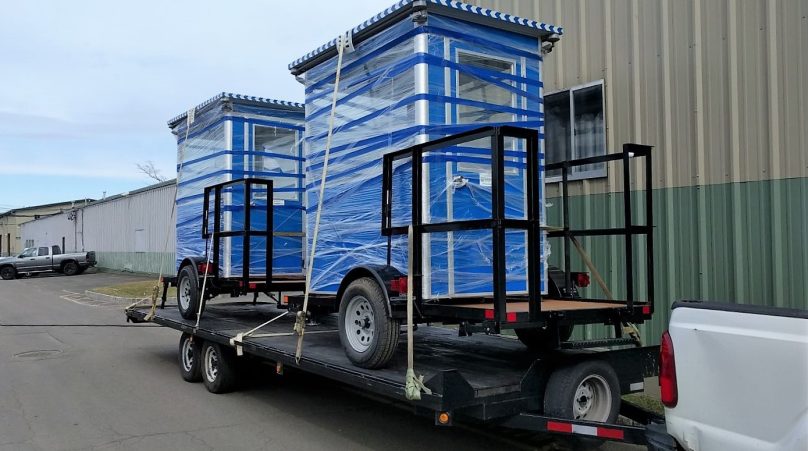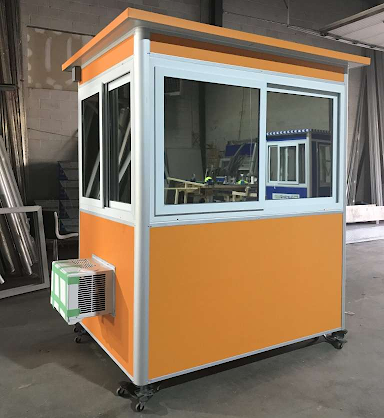The presence of a mobile security guard is an important aspect of your security plan; mobile security trailers are a significant part of creating that possibility. A trailer mounted guard booth provides a versatile way to guard your building, property or event. A guard shack or booth is a small building from which you and your employees can run your security activities. There are myriad advantages to having a guard booth on your property. But where are the best areas to put your trailer booth? And what other options do you have for installing the guard booth, other than mounting it on a trailer?
Let’s explore some guard shack trailer options to give you the most value for your guard shack on trailer.
Foundation Types for Your Guard Booth
When we talk about how to mount a booth, what we really mean is “what type of foundation options do I have?” A mobile security trailer is built with a solid floor that is intended to be placed on any number of hard, flat surfaces. But what is the best choice for your mobile guard shack trailer?
Often, the best option for your guard booth is to have it mounted on a trailer, as you see in the photo below.
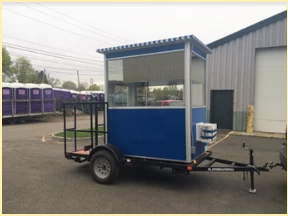
A trailer mounted guard shack provides stability and mobility, letting your guard shack work hard for you, so that you have an on site security trailer anywhere you need it. You can easily hook your trailer booth to any vehicle with a hitch, and then move your mobile security booth wherever you need it. With guard houses on trailers, you can easily move your trailer guard booth to one side of the property for one event, then to another area if your needs change. It also means you can move your guard house on wheels if you need to place it in storage for a season.
If you need to do any work on the booth, such as adding new accessories, lighting, or signage, you can easily move it to the area where the work needs to be done. Bottom line – trailer mounted booths provide versatility.
Do keep in mind that if your trailer booth is parked on any type of incline it is important that you make sure to use wheel chocks. In addition to setting the brakes, small caster wheel chocks are wedges of sturdy material that should be placed closely against security guard trailers wheels to prevent accidental movement.
Of course, there is another way to get some level of versatility without a full trailer mount; you can have your booth mounted on caster wheels (as is shown in the image below).
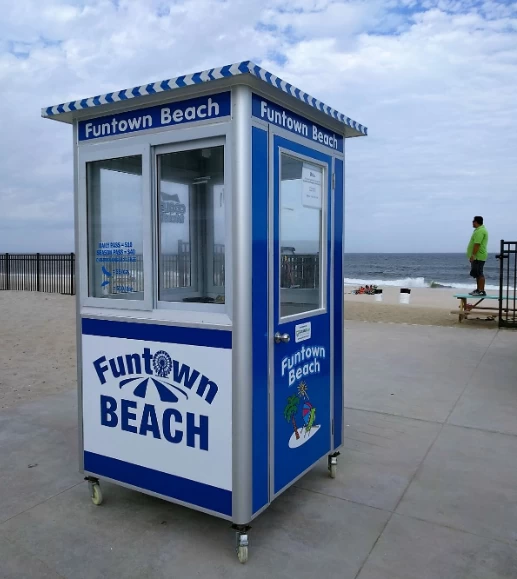
Caster wheels are a simple, cost effective way of giving a small guard booth versatility. With caster wheels, one or two adults can simply push the booth into the desired position. This is best when your booth will be on relatively smooth pavement, and will only be moved to another relatively smooth areas that are within easy walking distance. These wheels do not work well on sand, dirt, or mud, (though you can sometimes push them short distances on very solid grass or dirt — especially if it has frozen over). If necessary, you can even push these booths up a ramp and load them onto a truck to move it a longer distance.
Sometimes, though, you don’t anticipate needing to move your booth often at all. Alternatively, you may need a setup for booth plumbing. In these cases, a guard shack on wheels will not fit your needs – a fixed foundation could work just fine. There are many types of foundations that you can use to place a small building, such as a guard booth.
Examples of fixed foundations include:
Placing the guard booth on a wood foundation, one example of which is shown below:
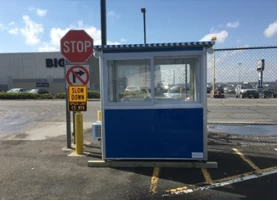
A a small wooden guard booth foundation can be just large “skids” as shown in this picture. But it can also be a wooden deck.
Another option can be placing the booth (without castor wheels) directly onto cement blocks, much like the foundations used in some homes (see photo).
Cement blocks are a sturdy, common way to provide a foundation for many sheds, manufactured homes, and shacks or booths. A portable cement slab is inexpensive and relatively easy to move.
A trailer booth can also be placed directly on a concrete slab, as shown here:
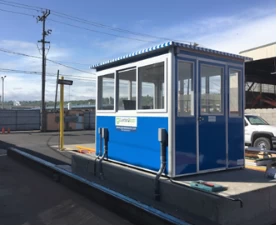
To stabilize your booth concrete is another option to consider. Since pouring a concrete slab is a bit of work and an expense, and is usually best left to a professional. A concrete slab can be a good choice when you are certain that you won’t want your booth to move for a very long time, and when you want it to be very firm and stable.
Another option is to mount your booth on an elevated platform. While this won’t allow you to move your booth at will, it has other benefits. Check out the picture below and imagine how this type of placement provides security, good looks, and a presence that really makes the guard booth visible:
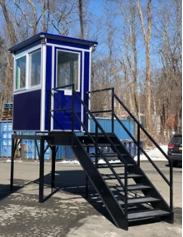
Making the Choice
Deciding which type of foundation to use is a personal choice that depends upon your needs, budget, and location. A poured concrete foundation can be expensive, and cost more than simply having your booth mounted on a movable trailer. A wood foundation can be inexpensive, but they can be difficult to get very level, can rot, and can be damaged or be lifted by heavy winds or floods. Similarly, concrete blocks are an inexpensive foundation, but they also can be tricky to get level, must be installed on firm, stable ground, and can be subject to sagging or falling from heavy winds or flooding.
Whether you are considering a security desk on wheels, mobile guard towers, a basic wooden guard shack, or guard towers for sale, talk to your Guardian Booth representative about your unique needs, specific location, and budget, and they can help you talk through all of your options.
Areas to Mount Your Trailer Booth
Now let’s consider where to put your guard booth or guard shack. With a trailer mounted guard booth or versatile trailer, you can place it almost anywhere that you can drive the vehicle towing it to. The same is essentially true for a poured concrete foundation, cement blocks, a wood foundation, and so forth – anywhere you find accessible, flat and firm ground. But what else do you need to consider?
When deciding where to put your booth, keep the following in mind:
Purpose: Of course, the primary consideration in placement should be how to let the guard booth function in the needed capacity. For example, if your biggest concern is keeping people off your property, your guard booth might be best placed near the driveway. If you are most concerned about the security of a nearby building, then you may want the both near the building entrance. Think through where your booth should be and where you want your guards spending much of their time.
Accessibility: Your booth has to be accessible. This means that you do not want it hidden away in a back corner. You do not want people to have to climb a hill to get to it, or wade through an area that you know becomes swampy after every rain. Choose an area where your employees can easily access the guard booth in most situations.
Visibility: A major benefit of a guard booth is that it serves as a deterrent to crime. That is, when a would-be criminal sees a prominent, lighted guard shack they are likely to just turn run instead of attempting foul play. Ensure your booth is in a place where it will be seen… and respected.
Utilities Needed: Most of the time you will want to run electricity to your guard booth. For some applications you may also want internet or plumbing. Ensure that you locate your shack near whatever utilities you need, or at least on a path where running lines to the utilities will be as easy and inexpensive as possible.
Choose the Right Placement
A security guard booth can be an indispensable part of your overall security plan; mounted security guards give you a great amount of flexibility. But be sure that you choose the right trailer, and mount it in the right place, safely. We also manufacture a wide range of portable guard towers and guard shack trailers that may help serve your security needs.
Need ideas for what type of booth to choose or where to put it? Considering booth storage trailers? Check out our Gallery of booth photos.
Your can also view our Gallery to see some really cool portable and mobile guard shacks.
Resources
How to Apply for Security Grants: A Step by Step Guide for Nonprofits


